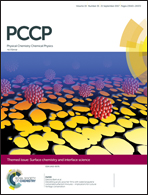Enhancing thermoelectrochemical properties by tethering ferrocene to the anion or cation of ionic liquids: altered thermodynamics and solubility†
Abstract
Entropic changes inherent within a redox process typically result in significant temperature sensitivity. This can be utilised positively or can be a detrimental process. This study has investigated the thermoelectrochemical properties (temperature-dependant electrochemistry) of the ferrocenium|ferrocene redox couple in an ionic liquid, and in particular the effect of covalently tethering this redox couple to fixed positive or negative charges. As such, the ionic liquid 1-ethyl-3-methylimidazolium bis(trifluoromethylsulfonyl)imide was employed to dissolve ferrocene, as well as cationic-tethered ferrocene (the 1-ethyl-3-(methylferrocenyl)imidazolium cation) and anionic-tethered ferrocene (the ferrocenylsulfonyl(trifluoromethylsulfonyl)imide anion). These systems were characterised in terms of their voltammetry (apparent formal potentials, diffusion coefficients and electron transfer rate constants) and thermoelectrochemistry (temperature coefficients of the cell potential or ‘Seebeck coefficients’, short circuit current densities and power density outputs). The oxidised cationic species behaved like a dicationic species and was thus 6-fold more effective at converting waste thermal energy to electrical power within a thermoelectrochemical cell than unmodified ferrocene. This was almost exclusively due to a significant boost in the Seebeck coefficient of this redox couple. Conversely, the oxidised anionic species was formally a zwitterion, but this zwitterionic species behaved thermodynamically like a neutral species. The inverted entropic change upon going from ferrocene to anion-tethered ferrocene allowed development of a largely temperature-insensitive reference potential based upon a mixture of acetylferrocene and ferricenyl(III)sulfonyl(trifluoromethylsulfonyl)imide.



 Please wait while we load your content...
Please wait while we load your content...